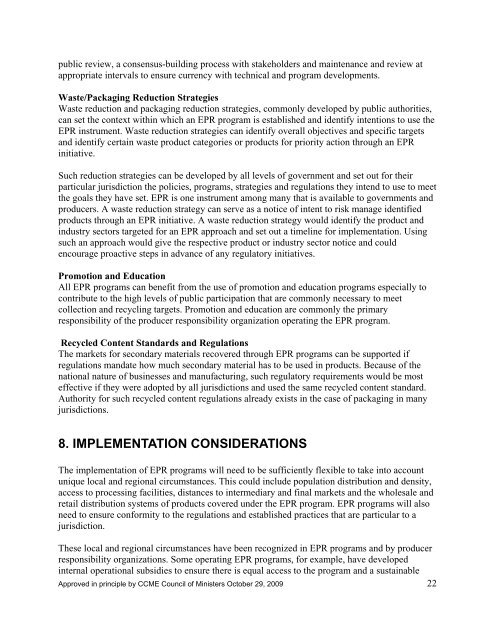Canada-Wide Action Plan for Extended Producer ... - CCME
Canada-Wide Action Plan for Extended Producer ... - CCME
Canada-Wide Action Plan for Extended Producer ... - CCME
You also want an ePaper? Increase the reach of your titles
YUMPU automatically turns print PDFs into web optimized ePapers that Google loves.
public review, a consensus-building process with stakeholders and maintenance and review at<br />
appropriate intervals to ensure currency with technical and program developments.<br />
Waste/Packaging Reduction Strategies<br />
Waste reduction and packaging reduction strategies, commonly developed by public authorities,<br />
can set the context within which an EPR program is established and identify intentions to use the<br />
EPR instrument. Waste reduction strategies can identify overall objectives and specific targets<br />
and identify certain waste product categories or products <strong>for</strong> priority action through an EPR<br />
initiative.<br />
Such reduction strategies can be developed by all levels of government and set out <strong>for</strong> their<br />
particular jurisdiction the policies, programs, strategies and regulations they intend to use to meet<br />
the goals they have set. EPR is one instrument among many that is available to governments and<br />
producers. A waste reduction strategy can serve as a notice of intent to risk manage identified<br />
products through an EPR initiative. A waste reduction strategy would identify the product and<br />
industry sectors targeted <strong>for</strong> an EPR approach and set out a timeline <strong>for</strong> implementation. Using<br />
such an approach would give the respective product or industry sector notice and could<br />
encourage proactive steps in advance of any regulatory initiatives.<br />
Promotion and Education<br />
All EPR programs can benefit from the use of promotion and education programs especially to<br />
contribute to the high levels of public participation that are commonly necessary to meet<br />
collection and recycling targets. Promotion and education are commonly the primary<br />
responsibility of the producer responsibility organization operating the EPR program.<br />
Recycled Content Standards and Regulations<br />
The markets <strong>for</strong> secondary materials recovered through EPR programs can be supported if<br />
regulations mandate how much secondary material has to be used in products. Because of the<br />
national nature of businesses and manufacturing, such regulatory requirements would be most<br />
effective if they were adopted by all jurisdictions and used the same recycled content standard.<br />
Authority <strong>for</strong> such recycled content regulations already exists in the case of packaging in many<br />
jurisdictions.<br />
8. IMPLEMENTATION CONSIDERATIONS<br />
The implementation of EPR programs will need to be sufficiently flexible to take into account<br />
unique local and regional circumstances. This could include population distribution and density,<br />
access to processing facilities, distances to intermediary and final markets and the wholesale and<br />
retail distribution systems of products covered under the EPR program. EPR programs will also<br />
need to ensure con<strong>for</strong>mity to the regulations and established practices that are particular to a<br />
jurisdiction.<br />
These local and regional circumstances have been recognized in EPR programs and by producer<br />
responsibility organizations. Some operating EPR programs, <strong>for</strong> example, have developed<br />
internal operational subsidies to ensure there is equal access to the program and a sustainable<br />
Approved in principle by <strong>CCME</strong> Council of Ministers October 29, 2009 22
















